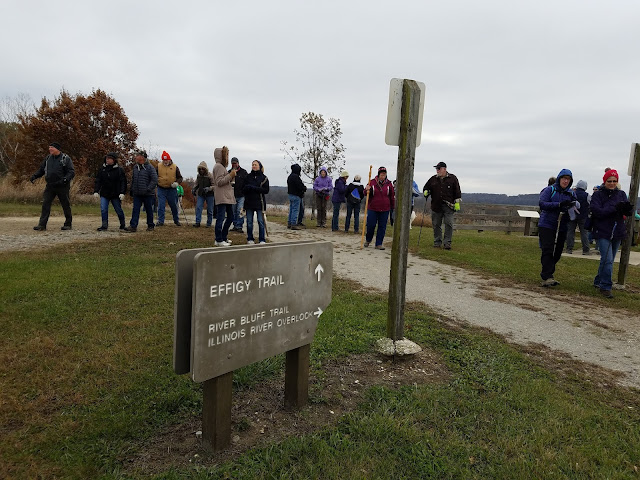 |
| Hiking at Buffalo Rock State Park |
We met in the Starved Rock Lodge's Lobby. After a few announcements we all carpooled to Buffalo Rock State Park. Today there were 2 dogs, and 36 hikers. The day was chilly and windy. Great day for a hike.
 |
| This sign is on the shelter where the "Buffalo" are in the park. |
 |
| The park staff does feed them. The walker's club has been here on occasion to see this happen. |
 |
| This viewing platform has signs that tell about the park and how it was formed. Artist Michael Heizer created the Effigy Tumuli, commissioned for the
task in 1983 by the Ottawa Silica Company Foundation. The art project,
coupled with efforts to plant grasses on the barren terrain, was meant
to reclaim the land left behind after the Buffalo Rock Coal Company and
Osage Coal Company strip-mined the area. The foundation paid the
artist's fees. |
 |
| One of 2 "Buffalo" |
 |
| View from the trail. |
 |
| Phragmites is an invasive reed plant that grows in wet grounds. |
 |
| View of the Illinois River. The land was mined between the 1930s and 1950s, then abandoned, left
empty of vegetation or wildlife due to highly acidic soil conditions.
The $1 million reclamation project was expected to help curtail erosion
of the unfavorable soil into nearby waters. The construction cost of the
project was paid by the Illinois Abandoned Mined Lands Reclamation
Council. The property, donated by Ottawa Silica Company, eventually
became part of Buffalo Rock. |
 |
| Buffalo Rock trails have very LITTLE protected areas. On windy cold days you really feel the wind chill. Jan is upgrading from a plain pair of gloves to a pair of Wool Mittens. Good Choice today! |
 |
| Heizer designed the sculptures as a tribute to the American Indian
burial grounds, hence the word "tumuli" in the name, referring to
man-made mounds usually erected over grave sites. He chose five animals
indigenous to the region -- a snake, catfish, turtle, frog and water
strider -- and replicated their forms to mimic the earthen mounds used
in Native American burial grounds in the Midwest. |
 |
| Ottawan Edmund Thornton, chairman of Ottawa Silica and president of its
foundation at the time the sculptures were commissioned, initially saw
the possibility of placing something artistic on the barren land after
showing it to his friend Eva J. Pope, a New York art consultant, who
suggested a sculpture park. The best way to see the sculptures is from the air, but since this
method is not readily available to visitors to the park, the next best
thing is to view them from a distance to gain some perspective, and then
walk on top of the mounds, using a healthy dose of imagination. |
 |
| Of the 5 sculptures this is the only one that is left whole. The other 4 have not held up as well. Some were damaged by the environment and some had some help by vandals. |
 |
| We took the trail to the top of the Catfish. The trail is about 1.5 miles long, meandering among the five sculptures
on 200 acres. It includes interpretive signs to help visitors understand
what they are seeing. Often the sculptures blend into the surroundings
so convincingly that visitors would see only hills rather than the
representations. The height of the sculptures range from seven to 18
feet and extend anywhere from several hundred feet in length to several
thousand feet. |
 |
| Some of the trails are closed in this park due to a tornado that did some destruction in Feb. 2017. They have been clearing some of the large tree falls, but some of the trails are still closed. |
 |
| "Riggs" waiting for his treat, for being so well behaved on the hike...... |
I will leave you with this: Wherever you go, no matter what the weather, always bring your own sunshine.
















No comments:
Post a Comment